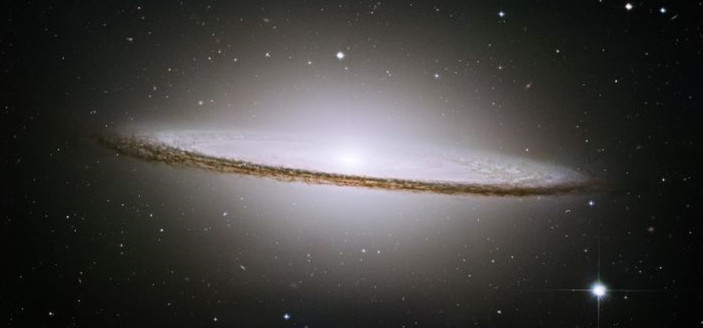The Milky Way’s star dust distribution precisely measured by SHAO astronomers


Figure 1: Image of the Sombrero Galaxy (also known as M104) from Hubble space telescope (upper). Cartoon of the dust and stellar distribution of the Milky Way from LAMOST data (bottom)
Look up on a dark summer night in the northern hemisphere and you will see a milky river of stars flowing across the sky. That’s the Milky Way. Lining the arms are lanes of visible “dark nebulae among the galactic stars.
These "black nebulae" are composed of neutral gases and interstellar dust. Dust not only helps the gases in the interstellar system cool down to form the next generation of stars, but also serves as the building blocks of the planets and our life. It plays a key role in the star formation, chemical enrichment and metal cycling of the stellar and planetary systems.
The spatial distribution of dust in galaxies provides important information about the structure and evolution of galaxies. Observations of extragalactic galaxies show that dust is abundant in disk-like galaxies, which also forms a remarkable disk-like structure. In general, dust disks appear radially more extended and thinner than stellar disks, as shown in Figure 1.
Unlike the extragalactic galaxies, whose overall structure can be directly observed, it is difficult to see the overall structure of the Milky Way, although the dust is almost visible to the naked eye.
Recently, the structure of dust component in the Milky Way Galaxy has been accurately modeled revealing the most accurate scale of the Galactic dust distribution so far. Astronomers from Shanghai Astronomical Observatory (SHAO) in the Chinese Academy of Sciences made the precise measurement using the massive stellar spectral data obtained by Guoshoujing telescope (LAMOST) survey. This study has been accepted for publication in the Astrophysical Journal.
Using the stellar spectra from LAMOST survey, a team of researchers led by Professor LIU Xiaowei of Peking University made an independent analysis of the stellar spectra and released a value-added catalog of a sample of millions stars, which listed the interstellar dust extinction values to all the sample stars.
Using these extinction value, LI Linlin, Ph.D student of SHAO, supervised by Professor SHEN Shiyin, has successfully constructed an analytical model for the overall spatial distribution of the interstellar dust in the Milky Way. It shows that the interstellar dust distribution in the Milky Way can be well described by a disk-like structure with an exponential decrease in both radial and vertical densities, after subtracting two very prominent substructures near the sun.
The scale-length and scale-height of the dust disk are approximately 10,000 and 330 light-years. Compared to the stellar disks measured based on the LAMOST data, the dust disk is more stretched radially and thinner vertically. Scientifically, this comparison is very instructive for studying the formation and evolution of the Milky Way.
“That is to say, if we are far away enough, the Milky Way will be very similar to other nearby disk galaxies, such as the Sombrero Galaxy from the edge-on view.” Prof. SHEN Shiyin from SHAO said. It further demonstrates that our Milky Way is a very typical disk-shaped galaxy, with no particularities in the Universe.
HOU Jinliang, the vice director of SHAO, also the third author of this study, says that this research has achieved unprecedented precision in measuring the overall structure of the Milky Way dust component, which is attributed to the massive data provided by the LAMOST to a certain extent.
Link to the research paper:
( https://arxiv.org/abs/1803.10540)
Science Contacts:
SHEN Shiyin, Shanghai Astronomical Observatory, Chinese Academy of Sciences, ssy@shao.ac.cn
LI Linlin, Shanghai Astronomical Observatory, Chinese Academy of Sciences, lilin@shao.ac.cn
News Contact:
ZUO Wenwen, Shanghai Astronomical Observatory, Chinese Academy of Sciences, wenwenzuo@shao.ac.cn
Download attachments:


